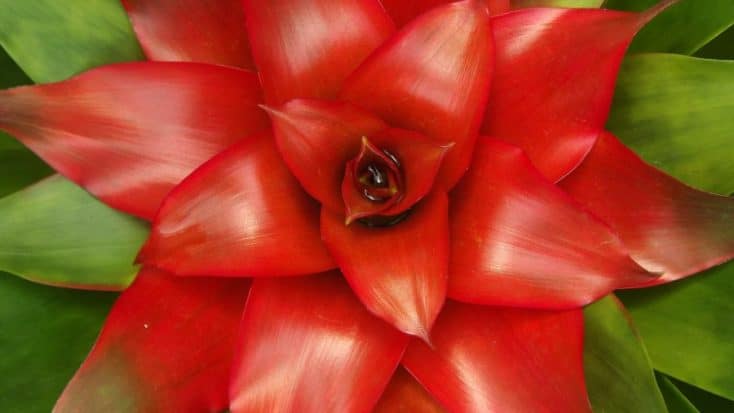Guzmanias (Guzmania spp.) are bromeliads belonging in the Bromeliaceae family with more than 120 different species, though you’ll probably only locate several of the more popular types at your local nursery. With proper care, these tropical beauties are hardy and easy to grow houseplants that add a colorful accent to indoor spaces. Here’s a quick summary of their care with more details outlined below.
How Do You Care For A Guzmania Plant: Grow Guzmania plants in soils that drain well, in a humid environment and in temperatures ranging between 60°F to 80°F. Water the Guzmania when the top inch of soil becomes dry, pouring into the center rosette, and fertilize every two months.
Continue reading because we take all the mystery out of caring for your Guzmania and keeping it happy and thriving, as well as problem-free.
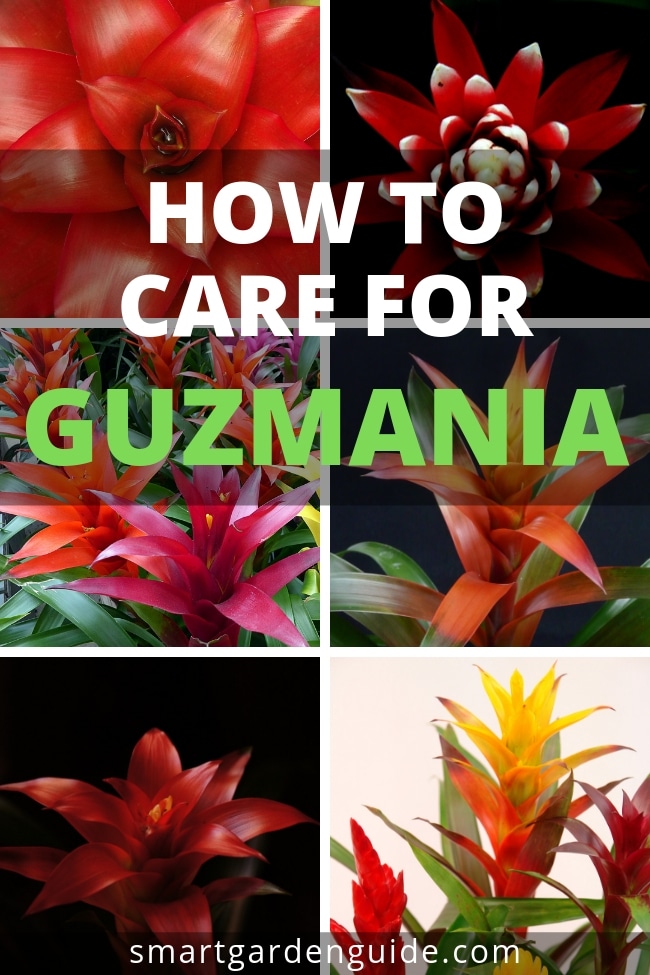
How Do You Care For A Guzmania Plant?
Guzmanias are evergreen perennials native to humid tropical and subtropical regions of the West Indies, Florida, Central America, Mexico and South America. They also grow in the rainforests of the Andes, thriving at altitudes of up to 3500 feet. Although many of the species have common names associated with their particular blooms, most are called vase plants, due to their vase-like habit of growth.
Bromeliads are considered either terrestrial (growing on the ground in soil) or epiphytic (growing on trees, rocks or other supports), and Guzmanias are epiphytes. Its threadlike roots attach to the branches in tree canopies or on rocks. However, it’s not considered a parasitic plant and does not harm or feed off the host supporting it.
Although an epiphyte in its natural environment, it can also be successfully grown in a potting medium. You can grow healthy Guzmanias by following a few important care tips, and even black thumb gardeners should find growing a Guzmania houseplant relatively simple.
Below we cover additional Guzmania care and growing tips, as well as the identification and prevention of potential problems.
Guzmania Soil
To promote the best growth and ward off potential problems such as rot, grow your Guzmania in soil that drains well and doesn’t remain soggy. You can use a commercial potting
You can also easily make your own potting mix for growing Guzmania plants by using:
- One part coarse sand
- One part bark
- One part peat
Preferred Light Conditions For Guzmania
When grown indoors, Guzmania prefers a location that receives bright but indirect light. This generally means that a south-facing window is too bright and the foliage may burn or discolor. If the leaves lighten and even turn yellow, the plant is receiving too much light.
On the other hand, if the foliage is dark green, begins drooping and turns soft, it’s not getting enough light. Although your Guzmania will survive in light conditions that are too low, it will cease growing and remain stunted.
If you decide to give your Guzmania a break from growing indoors when the weather warms outside, place it in a location that is shady to partially shady. Never situated it in the full sun.
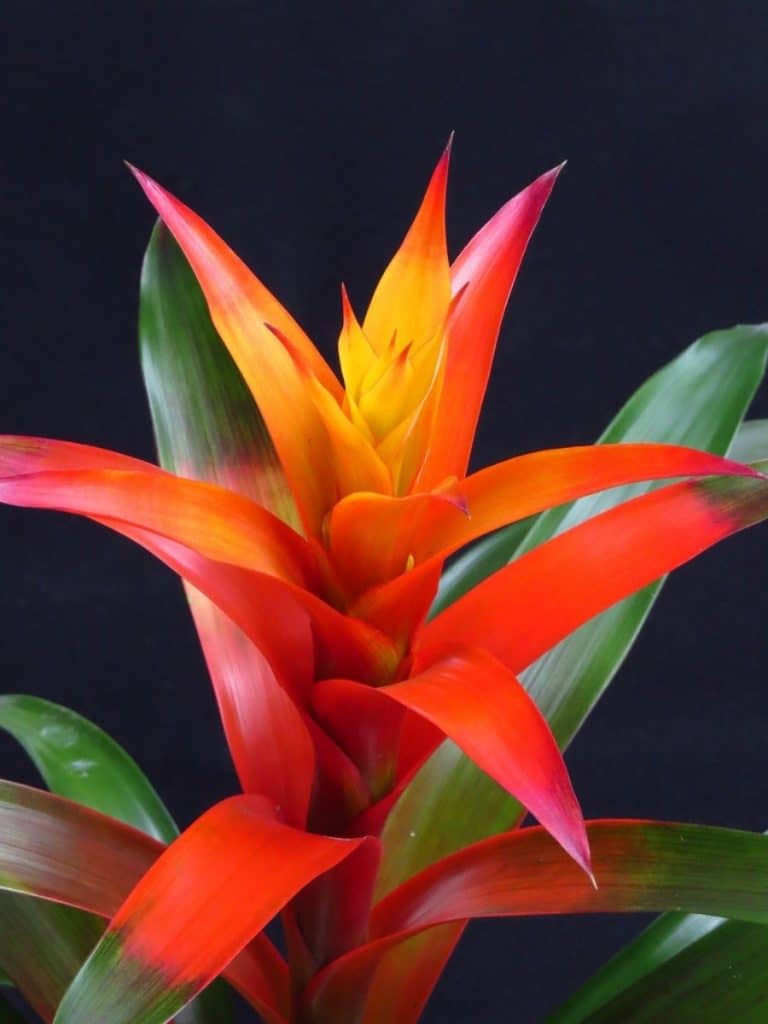
Guzmania Temperature Requirements
In their native habitat, Guzmanias grow in consistently warm tropical to subtropical climates and don’t tolerate freezing temperatures. They will thrive and perform well with indoor temperatures that are generally comfortable for you. Keeping temperatures inside the home between 60°F (15.5°C) to 80°F (26.6°C) is sufficient for good growth.
If you’ve placed your Guzmania outdoors to give it a break from indoor growth, make sure to bring it back inside before old man winter makes a visit bringing cold weather.
How To Water Guzmania
Guzmania has a moderate tolerance to drought conditions. It’s best to underwater than overwater, as conditions that remain too
The plant absorbs water through its leaves and center rosette, also called its cup or vase. When watering, apply to its center rosette, filling the cup with water. During spring and summer while the Guzmania is actively growing, you might have to fill the rosette with water several times weekly.
However, during winter when the plant is dormant (growth slows), you will only need to apply water about every two weeks. It’s always best to allow the soil’s top inch to become dry before applying another application of water.
Every month or so, take the Guzmania to the sink and flush the center rosette with water, especially if you are using standard tap water. Flushing the center cup removes any buildup of salts and minerals from the water or fertilizer used.
When applying water, try not to get any on the flowering section of the Guzmania (inflorescence), or you will end up shortening its life.
Humidity
In the Guzmania’s native environment, conditions are humid, so you need to replicate these conditions for the best growth. Creating humidity for your Guzmania is relatively easy and you have several options to mimic these conditions inside your home.
- Fill a spray bottle up with room temperature water and mist the foliage several times each week.
- Place the Guzmania’s container on a bed of pebbles that catch any water coming out of the bottom drain holes, creating humidity.
- If light conditions are adequate, situate the Guzmania in your bathroom where humidity is constantly created through showering and bathing.
How To Fertilize Guzmania
When grown indoors, Guzmanias are light feeders. They only require an application of fertilizer every other month during the growing seasons of spring through summer. During winter, the plant’s growth slows and goes into dormancy and feeding should cease.
You can use an all-purpose, water-soluble houseplant blend applied at half or a third strength. Apply the fertilizer to the soil and don’t pour into the Guzmania’s center rosette. This helps reduce the buildup of salts.
Flushing the center cup and soil every other month helps reduce any salts or minerals that have built up through fertilizing or watering.
Pruning Guzmania
Guzmania bromeliads have low requirements when it comes to pruning. If the tip of the plant’s leaves become brown or damaged, you can snip off the section with clean pruning tools. To keep the plant looking tidy, once the bloom has faded and died you can snip it from the plant.
To keep from transferring any pests or diseases to your Guzmania, be sure to clean your pruning tool blades before using on the plant. This is as easy as wiping off the blades with rubbing alcohol.
Potting & Repotting Needs
Since the main function of the Guzmania’s root system is to anchor it and not where it gathers the majority of its moisture or nutrients, it doesn’t require a large pot for proper growth.
However, as the plant grows it may become top heavy, so be sure the pot is large enough that it holds the plant upright and doesn’t tip over due to the top’s weight. You can also help anchor the pot and keep it upright by placing a rock on top of the soil.
Any type of container works well, as long as it drains from the bottom. You can also set the pot with drain holes into a decorative container, but be sure to empty any water that accumulates or your Guzmania can develop rot problems.
If you find you have a tendency to overwater your indoor plants, you might want to grow your Guzmania in a terracotta pot, as the soil dries quicker than soil in plastic pots.
Each Guzmania only lives about a year or two before it dies, so repotting the mother plant isn’t required. Don’t fret if your plant is about this age and you start to see it decline, as this is a natural occurrence. The good thing is the mother plant produces pups, so you can always have a Guzmania brightening up the inside of your home.
Mounting A Guzmania
Since Guzmanias are epiphytes, attaching to trees, rocks or other supports in its native environment, you can mount your Guzmania on a structure rather than growing it in a pot. Just make sure the wood you are using is untreated. Some good wood supports to use include:
- Tree fern slabs
- Cork bark
- Rosewood
- Oak
- Juniper
- Cedar
- Mesquite
Once you’ve selected your material for mounting, place the Guzmania on the mount where you desire it to grow. If it’s not a pup and has a developed root system, you’ll need to cover the roots with moist sphagnum moss. Keep the moss moist through regular water applications.
Secure the bromeliad to the mount by using string, fishing line, nylon stockings or wire that doesn’t contain copper. Just make sure the Guzmania is securely attached and doesn’t wiggle around so the root system will attach to the mount.
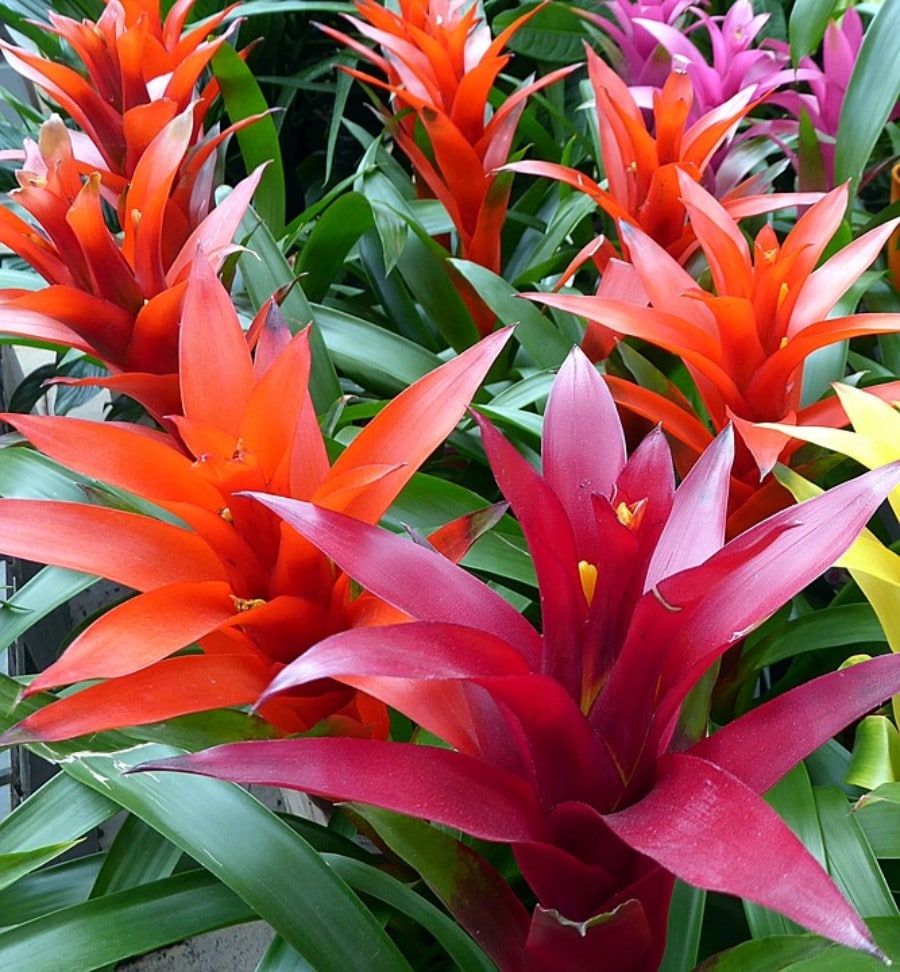
Propagating New Guzmania Plants
The mother plant produces babies (pups or offshoots), which you’ll see developing around its base. If the container is large enough, you can allow the baby Guzmanias to grow in the original pot, or you can remove them and pot them in separate containers. Repotting the babies is easy.
- Wait until the baby Guzmanias are about 4 inches tall before separating them from the mother plant.
- Gently pull the multiple babies apart or carefully cut them apart from each other, trying not to damage the small root system or foliage.
- Fill a 4-inch container with bottom drainage with a well-drained potting mix, if planting one baby per pot. If planting two Guzmania babies per pot, use a 6-inch container with bottom drainage.
- Make an indentation in the pot’s center that is large enough to hold the root system and plant the Guzmania in it, firming the soil up around its base with your fingers.
- Water after planting and place it in the same light conditions where it was originally growing.
It takes a Guzmania pup about one year to reach maturity.
Blooming
Mature Guzmanias naturally produce their colorful blooms in late winter through summer. Depending on the variety, colorful bracts in hues of red, yellow, orange and bi-colors form on tall spikes. The bracts surround small flowers in white or yellow. When properly cared for, the flower spikes can last for up to four months before dying.
To keep the flower spikes healthy and long lasting, don’t allow them to get wet when watering. Once the flowers die, you can snip them from the plant at their base.
You can force your Guzmania to bloom by placing a ripe apple inside a plastic bag and then covering the plant with the bag. Allow the plant to remain covered with the apple inside for about two to three days and then remove the bag. You should start seeing a bloom developing in about six weeks to three months.
Guzmania lingulatais the most common and most popular variety you will find available at your local garden centers. Mature plants grow up to 18 inches tall and with the many hybrids, the colorful bracts range in colors of red, orange and yellow. The foliage can be green or striped.
Guzmania Pest And Disease Problems
The biggest disease threat to indoor grown Guzmanias is problems with rot due to overwatering and keeping the soil mixture too wet. You can ward off this problem by watering when the top inch of soil is dry to the touch, using a well-drained potting mix and not growing in extremely large pots that have a tendency to have the soil remain too wet for too long.
Pests that sometimes affect Guzmania houseplants are scale, spider mites and mealybugs. All of these insects are sap-suckers, sucking the plant’s juices from the foliage. If an infestation is large and left untreated, all the pests will eventually kill the Guzmania. The pests can also infest your other houseplants, if left unchecked.
- Scale: Small, rounded pests that usually congregate in masses along the Guzmania’s foliage.
- Spider Mites: Tiny spider-like pests that usually cover the Guzmania in fine, white webbing.
- Mealybugs: The insects form cottony-like masses in the crotches of the foliage and along the leaves.
If the infestation is small, you can wipe the pests from the foliage using a damp cloth. However, if the infestation is large, you’ll need to use an insecticide to gain control and kill the pests. Spraying the Guzmania with an insecticidal soap and reapplying weekly usually controls the pest problem.
Why Is My Guzmania Turning Yellow?
If the foliage on your Guzmania is starting to turn yellow, it can be caused from three different things. If you haven’t been fertilizing the plant, it probably just requires feeding. Apply an all-purpose, water-soluble houseplant fertilizer, applied at half strength to a third strength, pouring onto the soil. Guzmanias only require feeding every other month.
If feeding isn’t the problem and the Guzmania is situated in a location with bright sunlight, it probably is getting too much light. Move it to a location with bright, diffused light.
On the other hand, if your Guzmania is over a year old, has bloomed and pups are developing around its base, it probably is just reaching the end of its lifecycle. All bromeliads naturally go through the process of dying once they’ve bloomed and produced pups.
How Do I Keep My Guzmania Bromeliad Alive?
Provided proper care for a
Place them in a warm indoor location that receives bright, indirect light and
How Often Do You Need To Water A Guzmania Bromeliad?
How often you will need to water your Guzmania depends on the season, the indoor temperature and the material of the container. During spring through summer while the bromeliad is actively growing, you might have to water several times each week. Stick your finger into the top inch of soil and if it’s dry apply water. Always apply water to the center rosette (cup) and you can allow any excess to flow over its side and into the soil.
During winter, when the Guzmania is dormant and its growth slows, you only need to water about every two weeks.
If your indoor temperature is warm the soil dries out quicker and you might need to water more often than when temperatures are cooler. In addition, if the Guzmania is growing inside a terra cotta pot, the soil will also dry out quicker than if planted in plastic, so this also means you might have to water more frequently.
Related Questions About Guzmania Plants
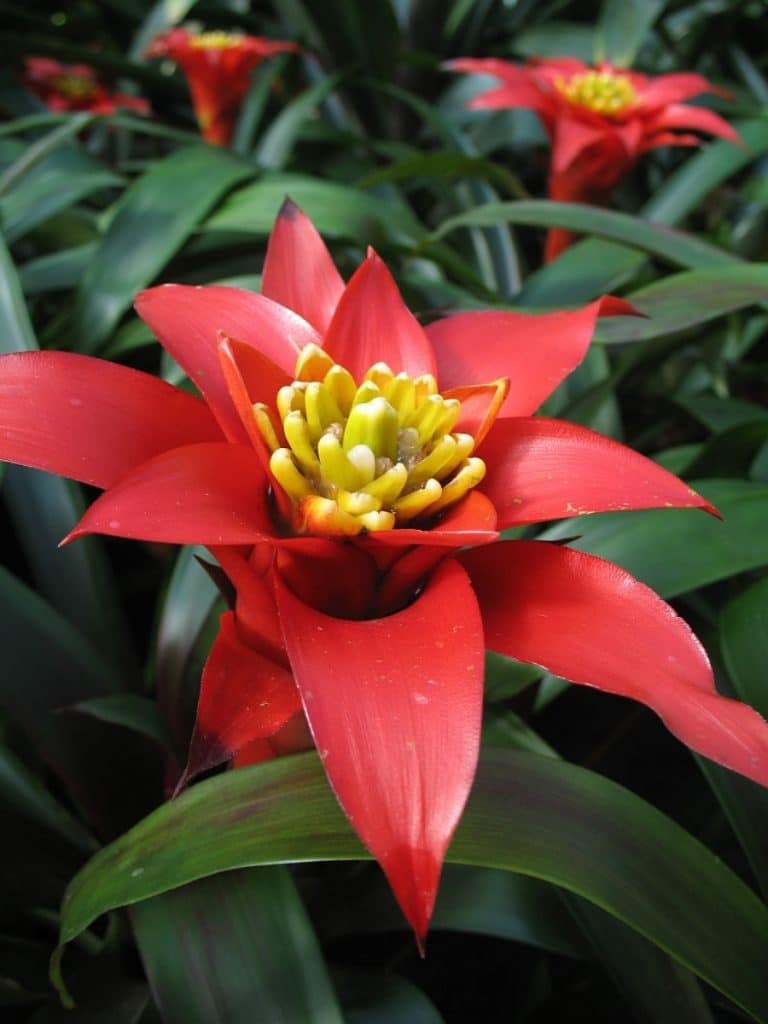
Do Guzmania Bromeliads Die After Flowering?
All types of bromeliads start their cycle towards death after flowering, although the process takes about a year. Fortunately, care for a
Do You Deadhead Guzmania Bromeliads?
Guzmania flowers can last up to four months and once spent, you can easily snip them from the plant using clean pruning tools.
How Long Do Guzmania Bromeliads Last?
Depending on its cultural environment and growing conditions, a Guzmania can live two years or longer before it starts to die.
What Does A Guzmania Bromeliad Eat?
About every two months, feed the Guzmania an all-purpose, water-soluble houseplant fertilizer applied at half-strength to a third of full-strength. Feed during the growing season of spring through summer and stop feeding during winter. Pour the solution over the soil.
How Much Sun Does A Guzmania Bromeliad Need?
When grown indoors, place the Guzmania in a location receiving bright, indirect light and never in full sun. The leaves will scorch and burn, or turn yellow if the plant receives too much direct sunlight.

